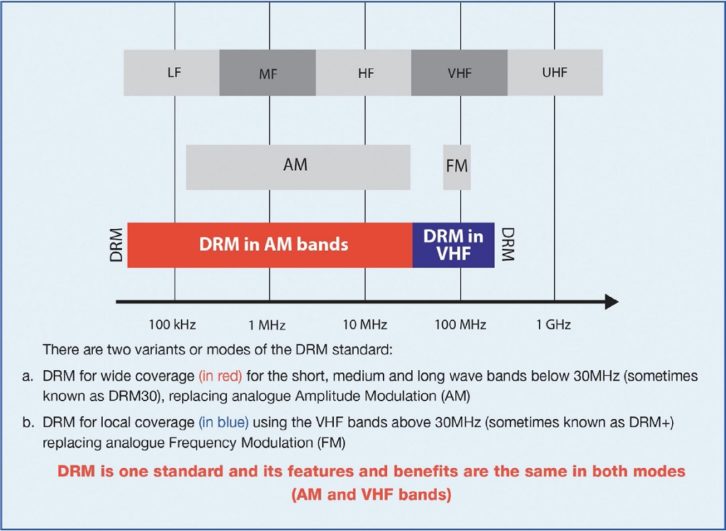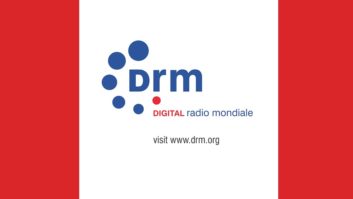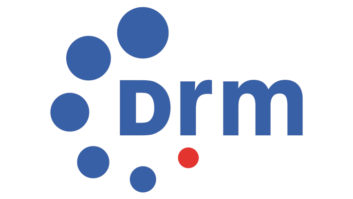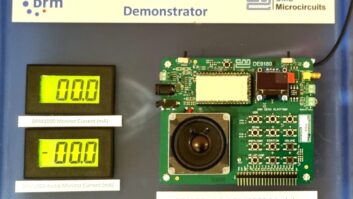The FCC recently adopted a Notice of Proposed Rulemaking that recommends giving AM stations in the United States the flexibility to adopt all-digital broadcasting voluntarily, based in part on the experimental experience of Hubbard station WWFD in Frederick, Md. The commission then asked for comments; one of the first was filed by Digital Radio Mondiale. Its filing is below, with minor edits for clarity. For background about DRM, see www.drm.org/what-is-drm-digital-radio/summary/.
In your document (FCC 19-123) you rightly highlight the great advantage of AM broadcasts, primarily the ability to cover large areas and number of listeners, while the band itself is losing popularity because of a variety of issues to do with propagation, interference [and] environmental changes. At the same time, digital audio broadcasting is no longer the new platform it was in 2002. At that time [the] FCC mandated a proprietary system (IBOC, “HD Radio”) as the only system to be used in the USA, with the possibility of applying DRM for HF.

Since then DRM (the ITU recommended, only digital audio broadcasting for all bands, open standard) has been tested and used all over the world on all bands, shortwave, medium-wave and FM.
So while you are recommending now pure digital HD, based on the NAB tests and [WWFD’s] not completely convincing trial, we would urge the FCC to consider opening the straightjacket of 2002 and allow DRM to be used as a sure, tested, efficient way of digitizing the AM band.
There are several reasons for this. DRM digital radio delivers, in the AM bands, significant benefits:
• Audio quality that is on par or better than FM. DRM, of all recognized digital standards, is the only one using the ultra-efficient and compressed xHE-AAC audio codec that delivers, at even very low bit rates, exceptional audio quality for speech, but music as well (www.drm.org/listen-compare/).
• Record Data: DRM has been tested in medium-wave all over the world in both simulcast and pure digital. A list of the main tests (some of which have become ITU adopted documents) are included in Annex 4 of the DRM Handbook (www.drm.org/wp-content/uploads/2019/02/DRM-Handbook.pdf). At the moment, 35 MW transmitters are on air in simulcast or pure DRM in India (http://prasarbharati.gov.in/R&D/).
• Auxiliary Data. DRM is the newest, most complete, open standard for digitizing radio in all frequency bands, and is recommended by ITU. DRM has been devised as a direct heir to analog AM (SW, MW). It uses 9/10, 18/20 kHz bandwidth and has a useful content bit rate of up to 72 kbps. It carries up to three programs on one frequency and one data channel, while data can be carried on each of the audio channels as well. One of the great advantages of DRM is that alongside excellent audio, the receiver screens will display visual information of any kind required (album titles, singer photos, maps, visuals of any sort, data of any kind). The Journaline application allows for extra information from the internet or the RSS feeds of the broadcaster to be captured and displayed. Currently broadcasters like the BBC, All India Radio [and] KTWR in Guam are using this extra facility that clearly differentiates digital [from] analog as a superior option.
- Power/energy efficiency. Using SW or MW in DRM can reduce the power used up to 80%. As per calculations made by Ampegon, a medium-wave transmitter can cover an area of 235,000 square kilometers with a 100 kW transmitter. The DRM ERP of such a transmitter is about 50 kW and the coverage area is the same, while instead of one analog program, up to three digital channels and one data channel can be broadcast, all in excellent audio quality.
- Spectrum efficiency (more programs can be broadcast on one single frequency used for one program in analog) as explained above.
- DRM, unlike analog, offers enhanced and stable audio quality that is FM-like (mono or stereo). DRM also offers multiservice data enabled by applications like Journaline (the enhanced text services, more information captured as RSS feeds or from other internet source), slideshows, multilingual text (practically being able to show any characters of any language, not just Latin script), and the Emergency Warning Functionality (EWF) in case of disasters.
- Interference. This has not been noted, as the DRM signal will always be lower than the analog one. AIR has not noted any interference in its operation of DRM transmitters. The mask values required for an optimal functioning of DRM transmitters [are] clearly stipulated in the ITU documents and as long as the network planning is correct and the mask is respected, there should not be any issue of interference in digital-analog or digital-digital DRM transmissions.
- Receivers. Currently there are several receiver models and SDR options for the reception of DRM in AM. India has almost 2 million new cars fitted with DRM receivers, at no cost to the buyers, that are capable of and are receiving DRM medium-wave signals. The audio quality is excellent and a sure benefit to the users.
- DRM is in direct succession to the analog AM (and FM) services, not owned or controlled by any single company, and immediately available with full know-how and technology access by the transmitter and receiver industry.
- As HD in medium-wave is a bit of a necessary step but still a leap in the dark, it would make sense from the practical aspects and even receiver solution availability to allow DRM as the best, clearly proven solution of digitizing the AM band (in preference or alongside HD) in the U.S.
In short, the salient advantages of DRM are:
- The audio quality offered by DRM is equally excellent on all the transmission bands: MW, SW or VHF
- Robust signal unaffected by noise, fading or other forms and interference in all bands
- Clear and powerful sound quality with facility for stereo and 5.1 surround
- More audio content and choice: Up to two and even three audio programs and one data channel on one frequency
- Extra multimedia content: Digital radio listeners can get multimedia content including audio, text, images and in future even small-scale video, such as:
a. Text messages in multiple languages
b. Journaline – advanced text-based information service supporting all classes of receivers, providing anytime-news for quick look-up on the receiver’s screen; interactivity and geo-awareness allowing targeted advertising
c. Electronic Program Guide (EPG), showing what’s up now and next; search for programs and schedule recordings
d. Slideshow Program accompanying images and animation
e. Traffic information
6. Automatically switch for disaster & emergency warnings in case of impending disasters in large areas, automatically presenting the audio message, while providing detailed information on the screen in all relevant languages simultaneously. Great potential to become the surest and widest means of alerting the population to emergencies.
Therefore, we urge [the] FCC to take a wide view and consider all options including DRM, if AM is worth future-proofing in the USA.
Comment on this or any article. Email [email protected] with “Letter to the Editor” in the subject field.
The DRM Consortium describes itself as an international not-for-profit organization composed of broadcasters, network providers, transmitter and receiver manufacturers, universities, broadcasting unions and research institutes. Its aim is to support and spread a digital broadcasting system suitable for use in all the frequency bands up to VHF Band III.










